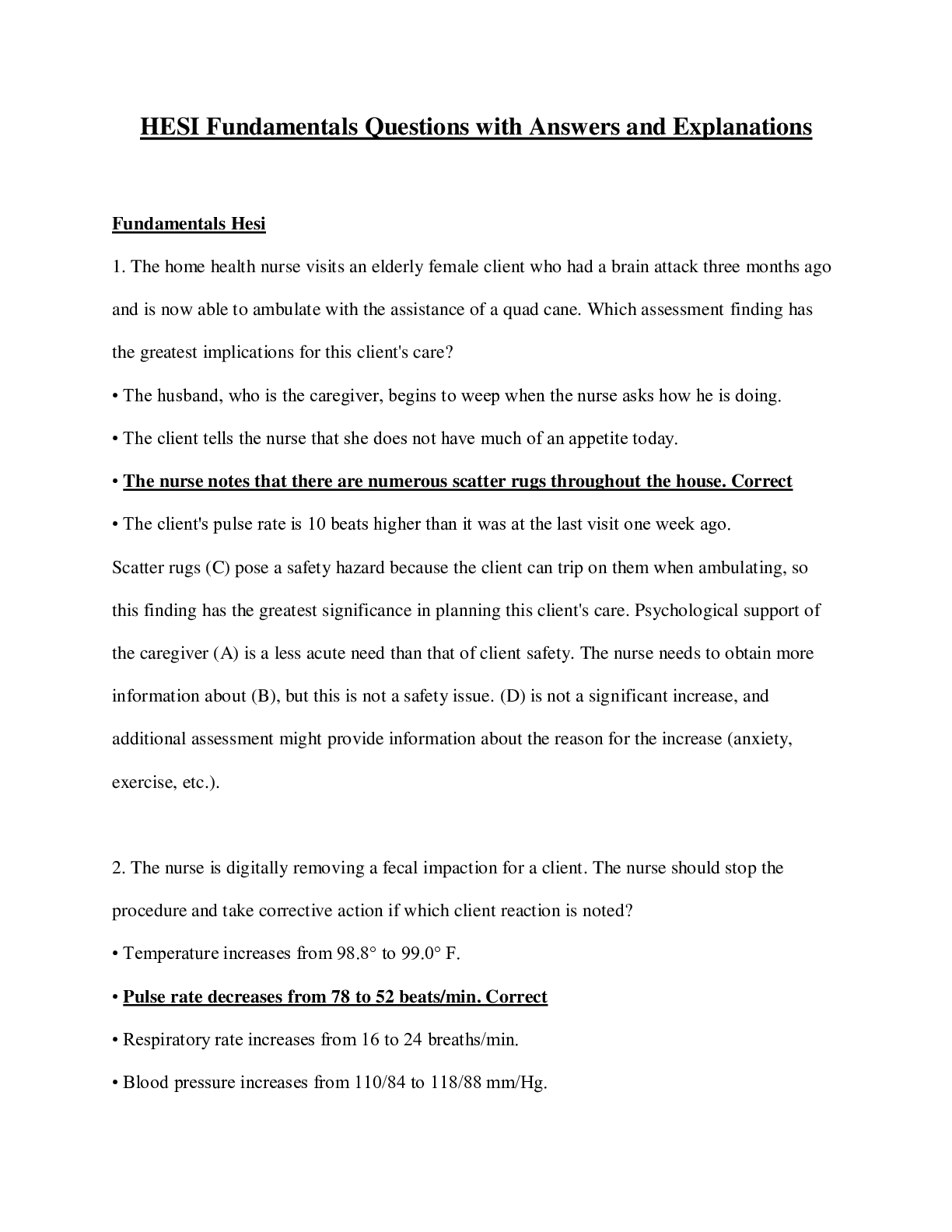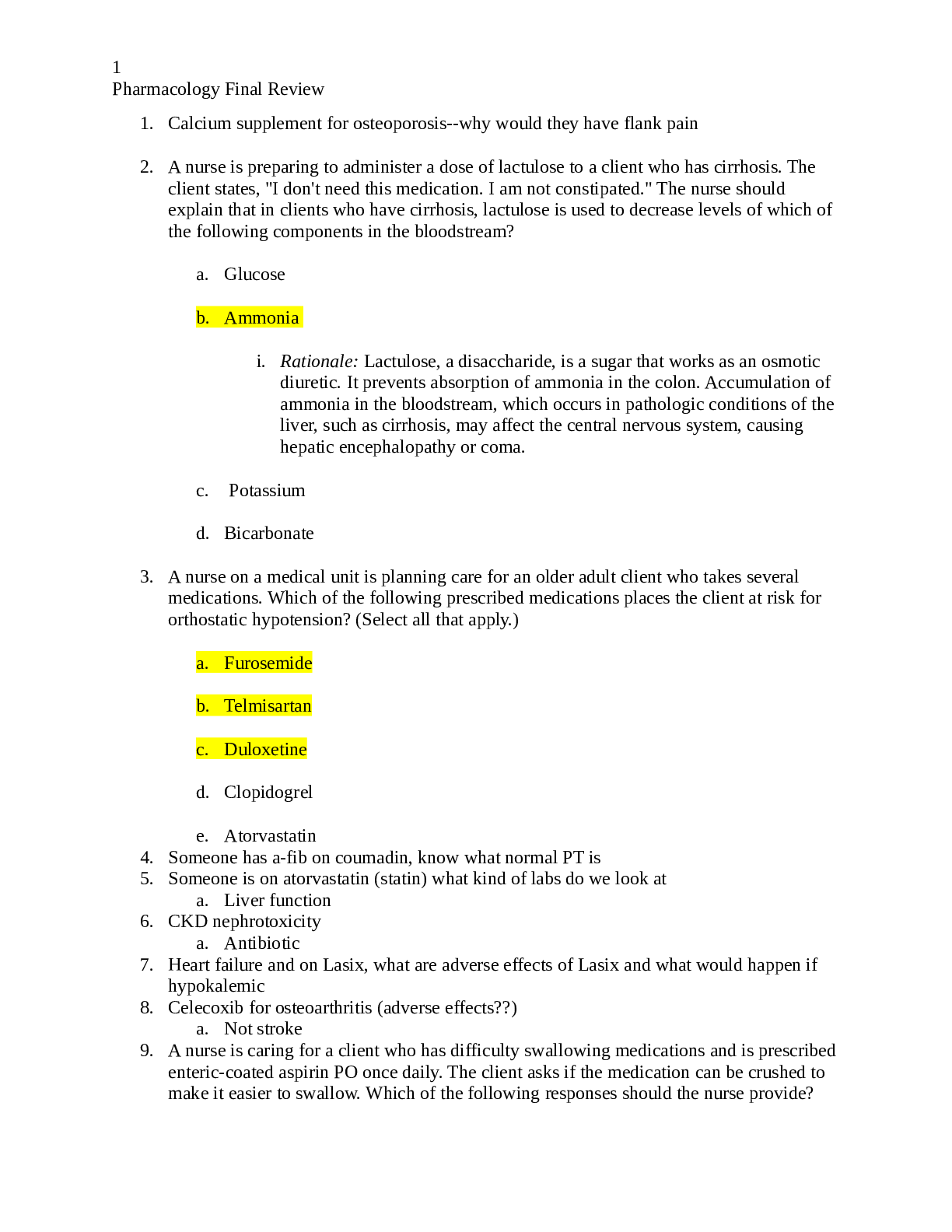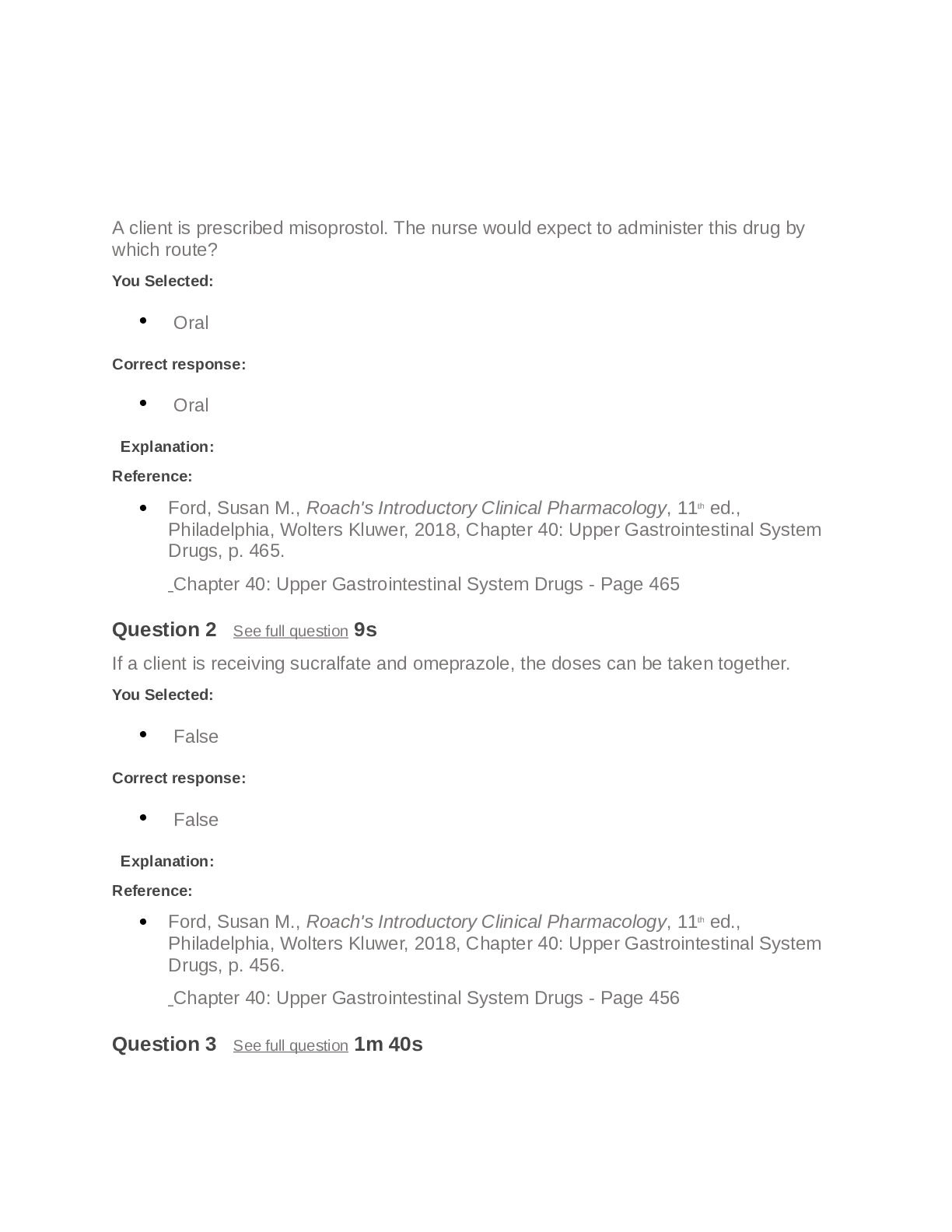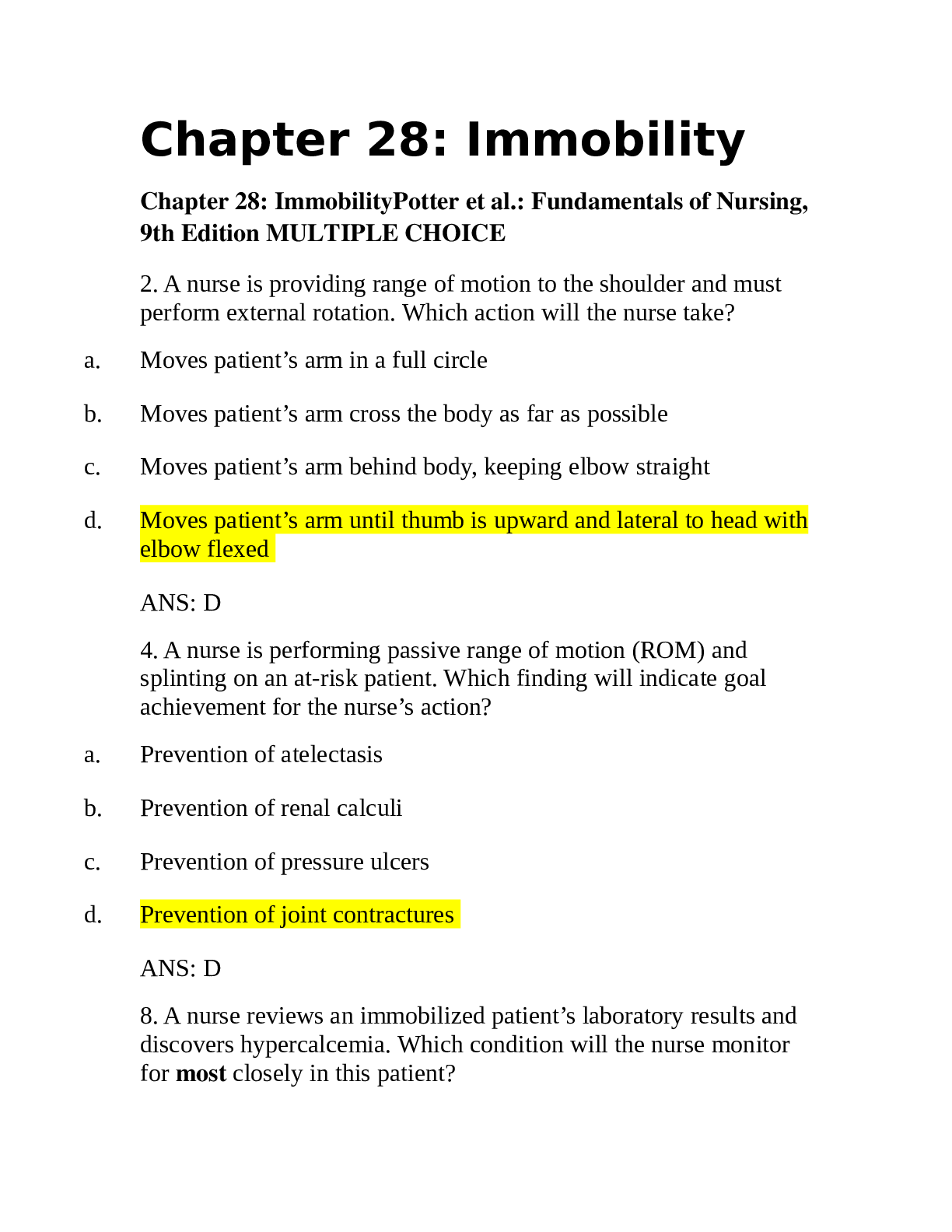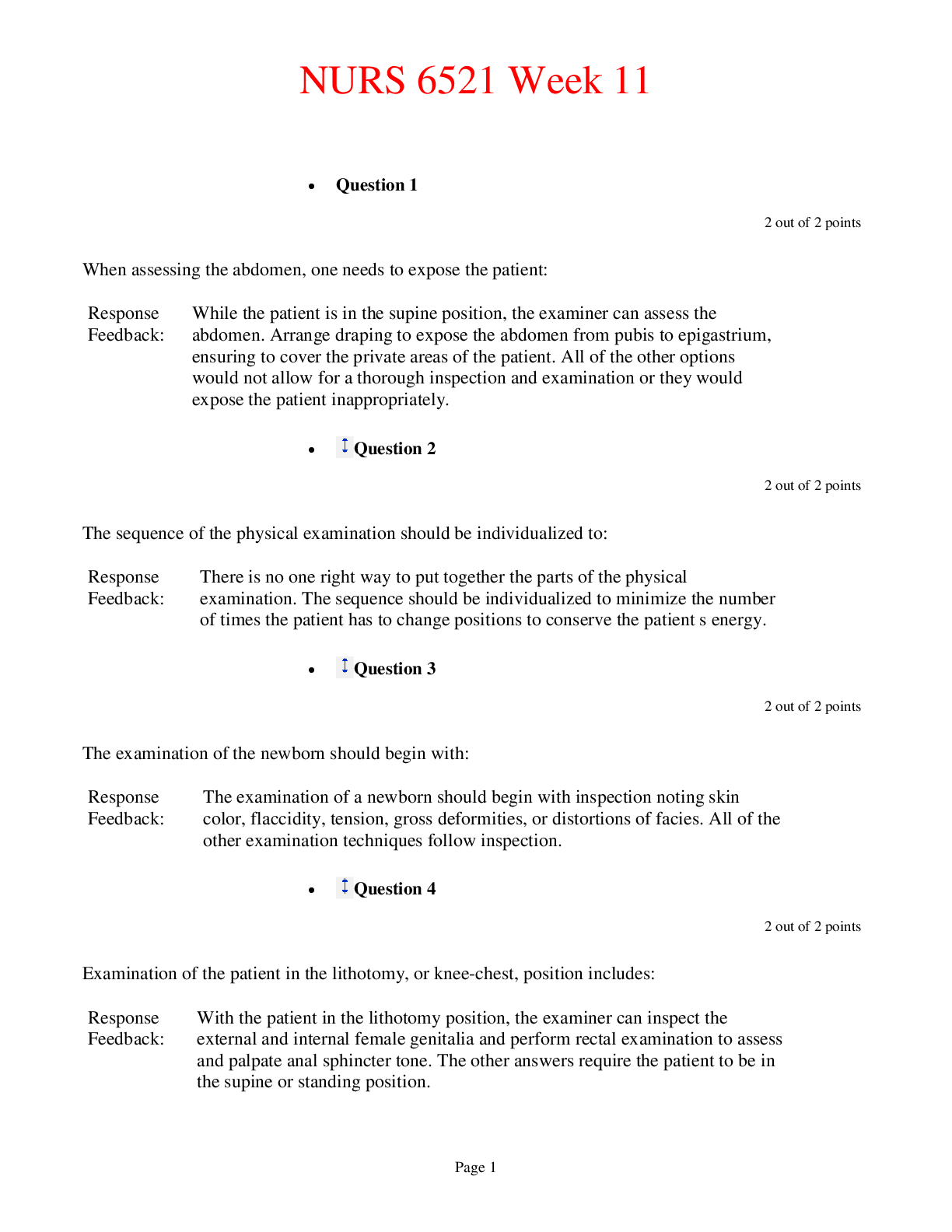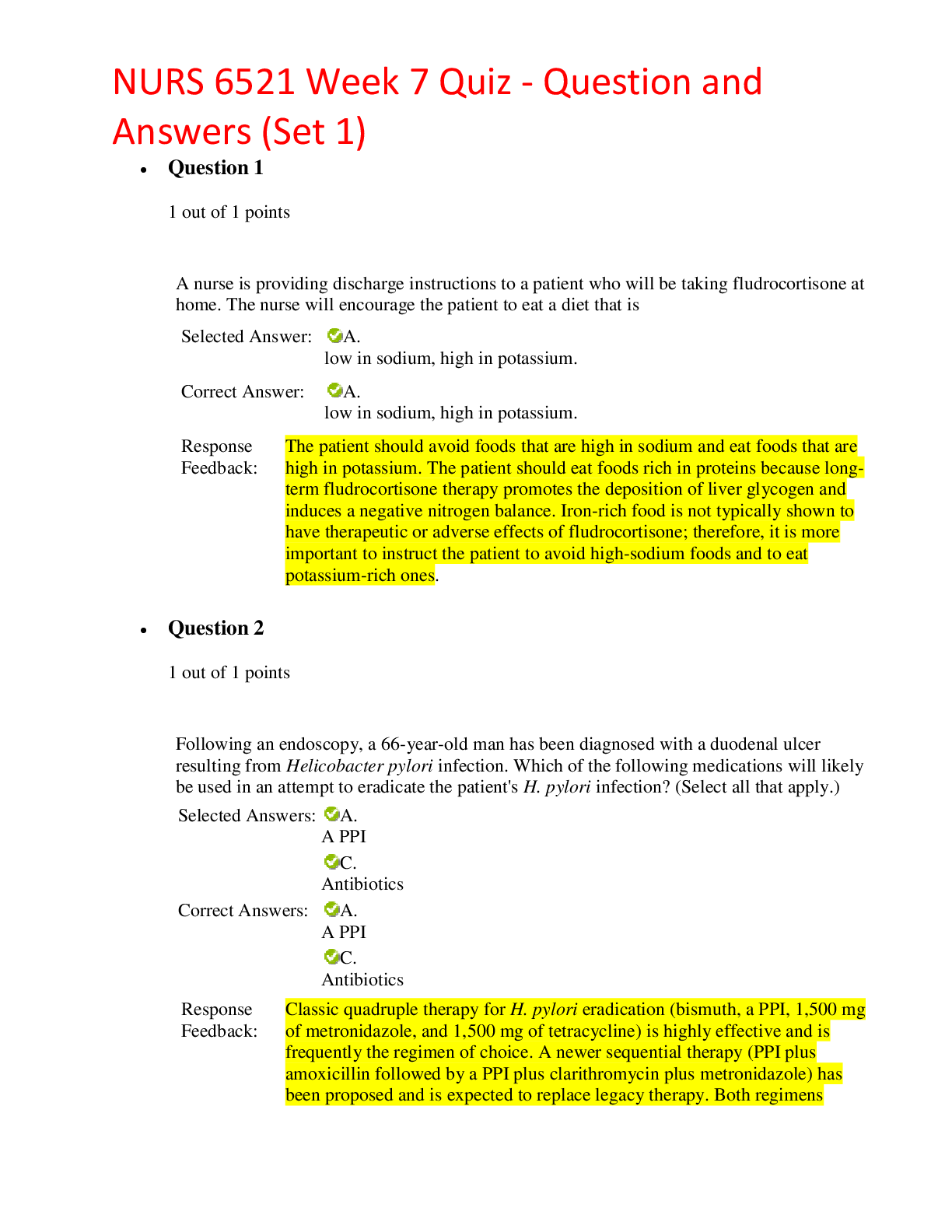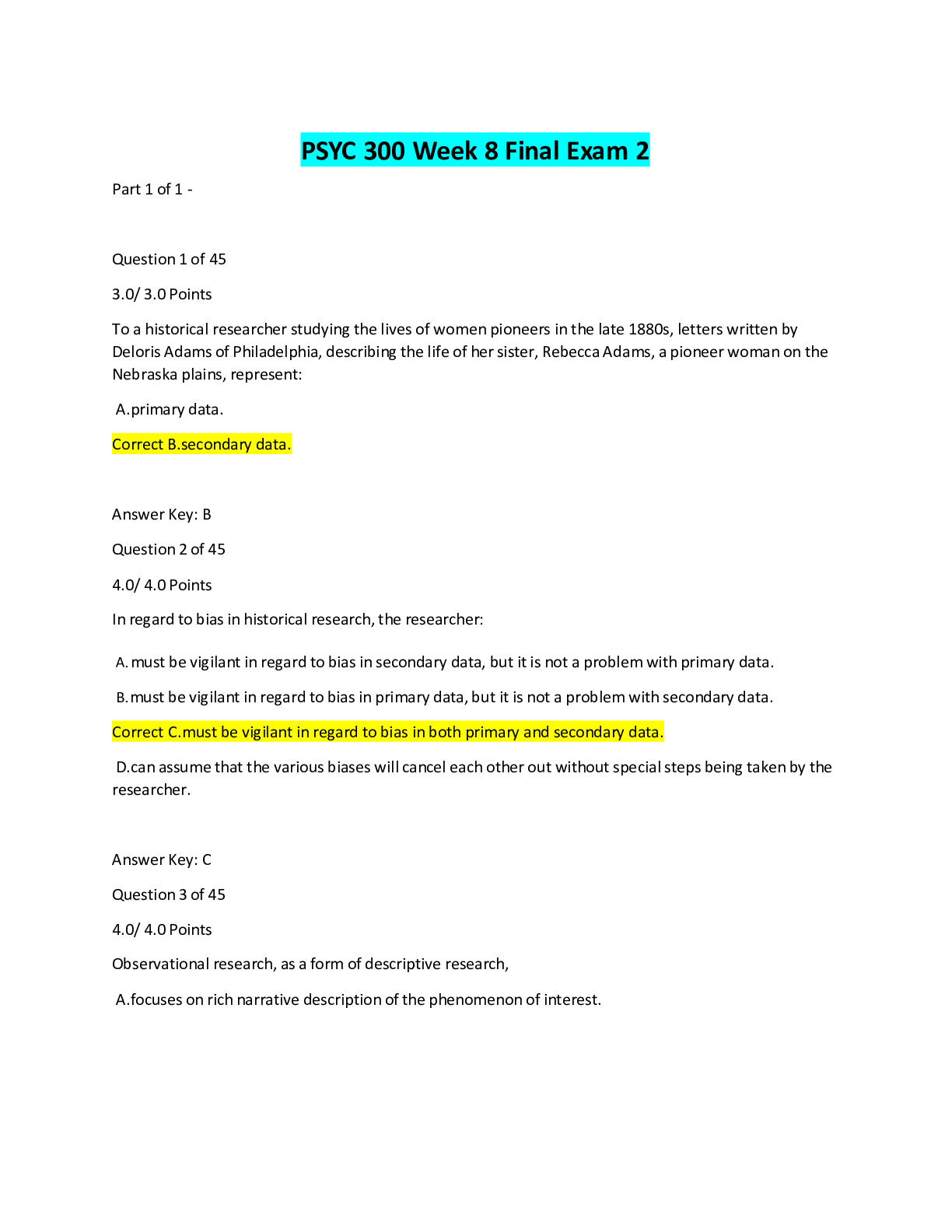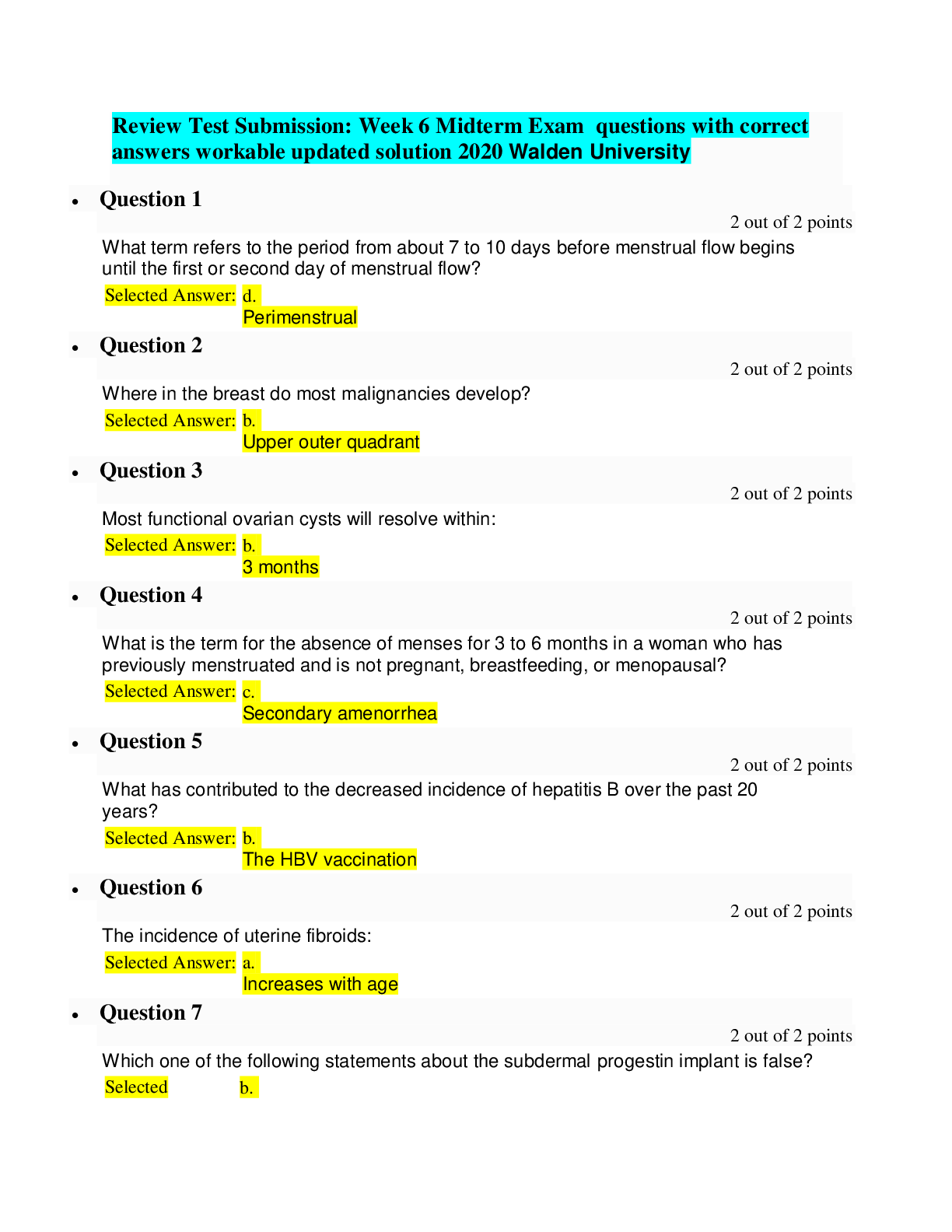*NURSING > QUESTIONS & ANSWERS > Professional Nursing III Cancer NCLEX STYLE QUESTIONS questions with correct answer selection (All)
Professional Nursing III Cancer NCLEX STYLE QUESTIONS questions with correct answer selection
Document Content and Description Below
Professional Nursing III Cancer NCLEX STYLE QUESTIONS questions with correct answer selection 1. Which of these does the nurse recognize as the goal of palliative surgery for the client with canc... er? A. Cure of the cancer B. Relief of symptoms or improved quality of life C. Allowing other therapies to be more effective D. Prolonging the client's survival time 2. Which statement made by the client allows the nurse to recognize whether the client who is receiving brachytherapy for ovarian cancer understands the treatment plan? a. "I may lose my hair during this treatment." b. "I must be positioned in the same way during each treatment." c. "I will have a radioactive device in my body for a short time." d. "I will be placed in a semiprivate room for company." 3. Which potential side effects should be included in the teaching plan for a client undergoing radiation therapy for laryngeal cancer? a. Fatigue b. Changes in color of hair -Chemotherapy, which causes alopecia, may cause changes in the color or texture of hair. c. Change in taste d. Changes in skin of the neck e. Difficulty swallowing 4. The client receiving chemotherapy will experience the lowest level of bone marrow activity and neutropenia during which period? a. Peak b. Trough c. Nadir-The lowest point of bone marrow function is referred to as the nadir. d. Adjuvant 5. The nurse teaches the client that intraperitoneal chemotherapy will be delivered where? a. Into the veins of the legs b. Into the lung c. Into the heart d. Into the abdominal cavity 6. The registered nurse is teaching a nursing student about the importance of observing for bone marrow suppression during chemotherapy. Select the person who displays bone marrow suppression. a. Client with hemoglobin of 7.4 and hematocrit of 21.8 - Bone marrow suppression causes anemia, leukopenia, and thrombocytopenia; this client has anemia demonstrated by low hemoglobin and hematocrit. b. Client with diarrhea and potassium level of 2.9 mEq/L c. Client with 250,000 platelets d. Client with 5000 white blood cells/mm3 7. The registered nurse would correct the nursing student when caring for a client with neutropenia secondary to chemotherapy in which circumstance? a. Student scrubs the hub of IV tubing before administering an antibiotic. b. Nurse overhears the student explaining to the client the importance of handwashing. c. Student teaches the client that symptoms of neutropenia include fatigue and weakness. d. The nurse observes the student providing oral hygiene and perineal care. 8. Which signs or symptoms should the nurse report immediately because they indicate thrombocytopenia secondary to cancer chemotherapy? Select all that apply. a. Bruises b. Fever c. Petechiae d. Epistaxis e. Pallor 9. .Which intervention will be most helpful for the client with mucositis? a. Administering a biological response modifier b. Encouraging oral care with commercial mouthwash c. Providing oral care with a disposable mouth swab d. Maintaining NPO until the lesions have resolved 10. A client who is undergoing chemotherapy for breast cancer reports problems with concentration and memory. Which intervention is indicated at this time? a. Explain that this occurs in some clients and is usually permanent. b. Encourage the client that a small glass of wine may help her relax. c. Protect the client from infection. d. Allow the client an opportunity to express her feelings. 11. Which client problem does the nurse set as the priority for the client experiencing chemotherapy-induced peripheral neuropathy? a. Potential for lack of understanding related to side effects of chemotherapy b. Risk for Injury related to sensory and motor deficits – Safety #1 c. Potential for ineffective coping strategies related to loss of motor control d. Altered sexual function related to erectile dysfunction 12. The nurse is caring for a client who is receiving rituximab (Rituxan) for treatment of lymphoma. It is essential for the nurse to observe for which side effect? a. Alopecia b. Allergy – most common s/e. c. Fever d. Chills 13. Which intervention will be most helpful in preventing disseminated intravascular coagulation (DIC)? a. Monitoring platelets b. Administering packed red blood cells c. Using strict aseptic technique to prevent infection - Sepsis is a major cause of DIC, especially in the oncology client. d. Administering low-dose heparin therapy for clients on bedrest 14. When caring for a client with suspected syndrome of inappropriate antidiuretic hormone secretions (SIADH), the nurse reviews the medical record to uncover which signs and symptoms consistent with this syndrome? Diagnostics Assessment Medications Na: 115 K: 4.2 Creatinine: 0.8 Neuro: Episodes of confusion Cardiac: Pulse 88 and regular Musculoskeletal: Weakness, tremors Ondansetron (Zofran) Cyclophosphamide (Cytoxan) a. Hyponatremia b. Mental status changes c. Azotemia - Azotemia refers to buildup of nitrogenous waste products in the blood, typically from renal damage. d. Bradycardia e. Weakness 15. The nurse anticipates administering which medication to treat hyperuricemia associated with tumor lysis syndrome (TLS)? a. Recombinant erythropoietin (Procrit) b. Allopurinol (Zyloprim)- Tumor lysis syndrome results in hyperuricemia, Allopurinol decreases uric acid production and is indicated in TLS. c. Potassium chloride d. Radioactive iodine 131 16. When caring for a client with cachexia, the nurse expects to note which symptom? a. Weight loss – cachexia is the physical wasting due to massive weight loss and muscle mass or atrophy caused by a preexisting disease. The disease causes severe weakness and a loss of weight, fat, and muscle. Anorexia often occurs during the same time b. Anemia c. Bleeding tendencies d. Motor deficits 17. When caring for a client who has had a colostomy created as part of a regimen to treat colon cancer, which activities would help to support the client in accepting changes in appearance or function? Select all that apply. a. Explain to the client that the colostomy is only temporary. - Ostomies may be temporary for bowel rest, such as after a perforation, but are typically permanent for cancer treatment. b. Encourage the client to participate in changing the ostomy. c. Obtain a psychiatric consultation. d. Offer to have a person who is coping with a colostomy visit. e. Encourage the client and family members to express their feelings and concerns. 18. The nurse has received in report that the client receiving chemotherapy has severe neutropenia. Which of the following does the nurse plan to implement? Select all that apply. a. Assess for fever. b. Observe for bleeding - Thrombocytopenia, or low platelet levels, cause bleeding, not low neutrophils c. Administer pegfilgrastim (Neulasta). d. Do not permit fresh flowers or plants in the room. e. Do not allow his 16-year-old son to visit. f. Teach the client to omit raw fruits and vegetables from his diet. 19. Which of the following findings would alarm the nurse when caring for a client receiving chemotherapy who has a platelet count of 17,000/mm3? Thrombocytopenia (Norm: 150,000-450,000) a. Increasing shortness of breath b. Diminished bilateral breath sounds c. Change in mental status - A change in mental status could result from spontaneous bleeding; in this case, a cerebral hemorrhage may have developed. d. Weight gain of 4 pounds in 1 day 20. Which teaching is most appropriate for a client with chemotherapy-induced neuropathy? a. Bathe in cold water. b. Wear cotton gloves when cooking. c. Consume a diet high in fiber – help with constipation d. Make sure shoes are snug. 21. The nurse is teaching a client who is receiving an anti-estrogen drug about the side effects she may encounter. Which of these should the nurse include in the discussion? Select all that apply. a. Heavy menses b. Smooth facial skin c. Hyperkalemia d. Breast tenderness e. Weight loss f. Deep vein thrombosis (DVT) 22. Which medication does the nurse plan to administer to a client before chemotherapy to decrease the incidence of nausea? a. Morphine b. Ondansetron (Zofran) c. Naloxone (Narcan) d. Diazepam (Valium) 23. A newly graduated RN has just finished a 6-week orientation to the oncology unit. Which of these clients would be most appropriate to assign to the new graduate? a. A 30-year-old with acute lymphocytic leukemia who will receive combination chemotherapy today - This is a complex client requiring a nurse certified in chemotherapy administration. b. A 40-year-old with chemotherapy-induced nausea and vomiting who has had no urine output for 16 hours - This client is developing acute renal failure and requires complex assessment and treatment. c. A 45-year-old with pancytopenia who will require IV administration of erythropoietin (Procrit) - administration of medications to stimulate the bone marrow. d. A 72-year-old with tumor lysis syndrome who is receiving normal saline IV at a rate of 250 mL/hr - This client has complicated needs for assessment and care and should be cared for by RNs with more oncology experience. 24. The RN working on an oncology unit has just received report on these clients. Which client should be assessed first? a. A client with chemotherapy-induced neutropenia who has just been admitted with an elevated temperature b. A client with lymphoma who will need administration of an antiemetic before receiving chemotherapy c. A client with metastatic breast cancer who is scheduled for external beam radiation in 1 hour d. A client with xerostomia associated with laryngeal cancer who needs oral care before breakfast 25. The outpatient client is receiving photodynamic therapy. Which environmental factor is a priority for the client to adjust for protection? a. Storing drugs in dark locations at room temperature b. Wearing soft clothing c. Wearing a hat and sunglasses when going outside - The client will be homebound for 1 to 3 months after the treatment and should not go outside. d. Reducing all direct and indirect sources of light -Lighting of all types must be kept to a minimum. It can lead to burns of the skin and damage to the eyes because they are sensitive to light. 26. Which manifestation of an oncologic emergency requires the nurse to contact the health care provider immediately? a. New onset of fatigue b. Edema of arms and hands - indicates worsening compression of the superior vena cava consistent with superior vena cava syndrome. The compression must be relieved immediately, often with radiation therapy, because death can result without timely intervention. c. Dry cough d. Weight gain [Show More]
Last updated: 1 year ago
Preview 1 out of 5 pages
Instant download
 answers.png)
Buy this document to get the full access instantly
Instant Download Access after purchase
Add to cartInstant download
Reviews( 0 )
Document information
Connected school, study & course
About the document
Uploaded On
Jan 12, 2021
Number of pages
5
Written in
Additional information
This document has been written for:
Uploaded
Jan 12, 2021
Downloads
0
Views
43



